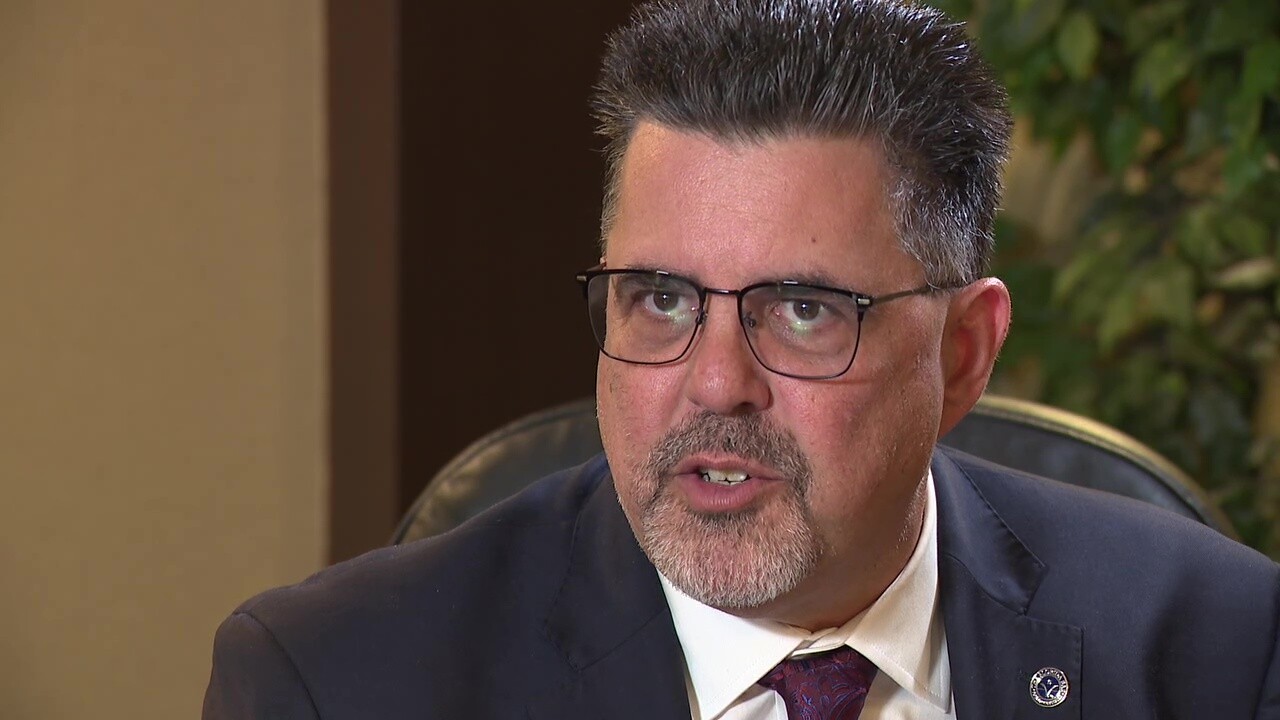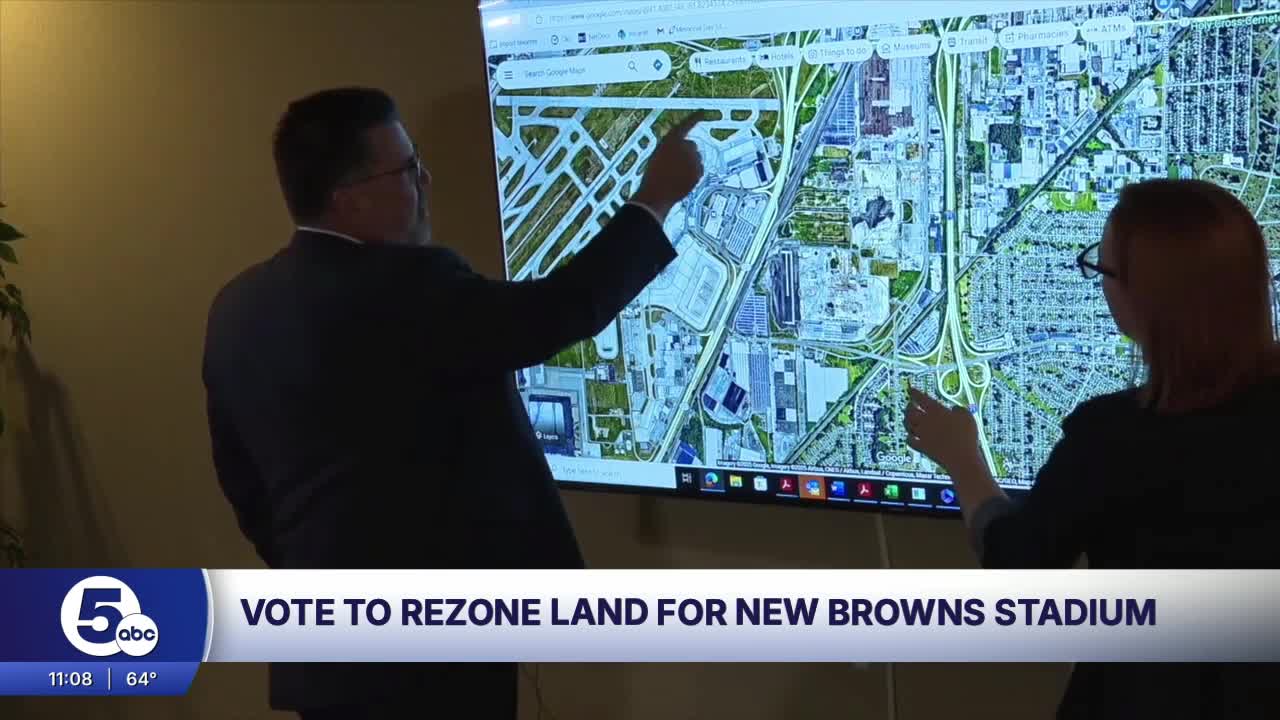BROOK PARK, Ohio — Brook Park City Council voted late Thursday to rezone the proposed site for a new Cleveland Browns stadium, making way for the project despite unresolved questions about whether the building will be a hazard to passing planes.
Council members approved the land-use change in a 6-to-1 vote as Haslam Sports Group executives and roughly a dozen community members looked on.
The vote opens up a 176-acre industrial site for mixed-use redevelopment, with apartments, hotels, retail and offices planned around a new, enclosed Huntington Bank Field.
RELATED: Brook Park moves to rezone potential Browns stadium site
“Every day, there’s more work to be done. We have a lot of work to do tomorrow, so we’re going to continue to keep working hard. But tonight is a great, monumental, historical day for the city of Brook Park,” Mayor Edward Orcutt said after the council vote.
He expressed confidence that Haslam Sports Group will find a way to sort through a disagreement between federal and state aviation officials over whether the stadium project is too tall.
Citing objections from nearby Cleveland Hopkins International Airport, the Ohio Department of Transportation's aviation office recently denied a permit for the project.
RELATED: ODOT rejects new Browns stadium as too tall. Browns push back, citing FAA's OK.
“More due diligence is happening, obviously, to rectify that,” Orcutt said at the start of Thursday night’s public meeting. “And I have 1000% confidence that this project will be a go here in the city of Brook Park.”
Haslam Sports Group President Dave Jenkins provided a brief overview of the team’s plans during the meeting. But he and other executives did not take questions after the vote.
“The plan is to start moving dirt this fall, with more of a ceremonial groundbreaking this spring,” Jenkins told the audience.
The Browns envision a $2.4 billion stadium — paid for with a mix of public and private money — on the property.
The venue would be flanked by private development and 12,000 on-site parking spaces.
Their goal is to open the stadium and the first phase of that mixed-use development in 2029, after the team’s lease with the city of Cleveland ends at the existing stadium on the Downtown lakefront.
It’s unclear how much the recent dust-up over airspace will impact those plans or that timeline. The Federal Aviation Administration signed off on the stadium project in May, after initially asking the Browns to reduce the height of the development.
But ODOT’s aviation office says the team needs to shave 58 feet off the project – or shift it to another location.
In an Aug. 1 denial letter, state officials said the team’s lawyer can seek a hearing to challenge the decision. An attorney for Haslam Sports Group has pushed back in writing, citing the FAA approval.
It’s not uncommon to see disagreement between federal and state aviation officials, said Jason Lorenzon, an aviation lawyer at Gertsburg Licata in Independence.
“This happens across the country,” said Lorenzon, who is also a pilot and an assistant professor at Kent State University. “And here, I really think all parties are doing the right thing. They’re trying to figure this out.”

He said ODOT and Hopkins officials have standing here – and legitimate concerns. State law says ODOT can consider the findings and positions of other government entities and interested parties when it comes to granting or denying a permit.
But the Ohio Revised Code says ODOT isn’t obligated to follow recommendations from other governmental entities, Lorenzon noted.
In this case, ODOT’s aviation office is deferring to the people on the tarmac on the other side of the freeway – not federal regulators in other states.
“Looking at the different maps … the east-west runway, yeah, it’s pretty close to the stadium,” Lorenzon said of the layout at Hopkins. “And a lot of times, a plane’s coming in, if the day’s cloudy and it’s rainy, they don’t have the ability to actually look out the window, they’re 200 feet above the ground. And the last thing they want to see is the stadium and not the runway. And those are possibilities that could happen. And you don’t want to have that. You don’t want to have an accident with something that’s very close to the runway.”
In letters to ODOT and the FAA earlier this year, Cleveland’s top airport official said the stadium project would “permanently and negatively impact” the airspace at Hopkins.
He said the development would force changes to approach minimums for pilots and cause particular problems for a runway that runs parallel to Brookpark Road.
The proposed stadium would sit south of that runway. But Lorenzon said that's an area where a pilot might have to turn sharply – or where a plane could get blown off course.
That doesn’t necessarily mean the ODOT denial will derail the stadium deal.
"I don’t think this is a deal-killer," Lorenzon said.
He doesn’t expect officials at Hopkins, which is owned by the City of Cleveland, to back down. But he believes there’s room for Haslam Sports Group and aviation officials to find a solution, even if that involves moving the stadium around on the site or digging deeper into the ground.
“I’ve seen that situation happen, where the applicants are going to say, ‘Hey, can we do it this way? Will this work?’” he said. “And usually, that’s how these things resolve. The end result here should be a beautiful stadium that everybody can be proud of, the Browns can be proud of, our community can be proud of.”

That’s what leaders in Brook Park are hoping for.
“We’re excited and we want to make this work,” Councilman Steve Roberts, whose ward includes the development site, said during an interview before the public hearing.
“It will get worked out one way or the other,” he said of the debate over the stadium’s height. “I’m pretty confident the Browns did their homework on this.”
During the meeting, Councilman Brian Poindexter said he believes the project will be a win for the region – not just for Brook Park.
“To me, it’s a better product than what we have now. And anytime you have a better product, that bodes well for the area as a whole,” he said. “I am a little disappointed, however. I’m disappointed that this once-in-a-lifetime project hasn’t been welcomed by people who should be welcoming it.”
Councilman Tom Troyer voted against the rezoning. He said he's not opposed to the project and likes the idea of mixed-use development. But he has concerns about the rezoning legislation, which creates a flexible district that will allow everything the Browns want to build — while leaving wiggle room for other uses, including warehouses and healthcare facilities.
Brook Park’s planning commission will have a say on many aspects of the project, but only an advisory role when it comes to stadium design.
"I'm not gonna give up the farm for a shiny red tractor, and I believe this is the start of that," Troyer said, adding that he needs to see more information to evaluate the project properly.
Only a few audience members spoke up during a public hearing that preceded the council vote. They applauded the mayor and other city officials, expressed enthusiasm about the Browns and asked questions about traffic, access to public transportation, stormwater management and policing.
Orcutt said the city will hold more public meetings once consultants working with Brook Park and the Browns finish a traffic feasibility study for the area. That study is expected to be complete and submitted to ODOT by mid-September.
“The whole project is a big lift, so we know that there’s gonna be a lot of work,” Orcutt said after the council vote. “There’s gonna be differences of opinions. But what we’re going to do is make sure that we provide facts to be able to make this project a reality.”






